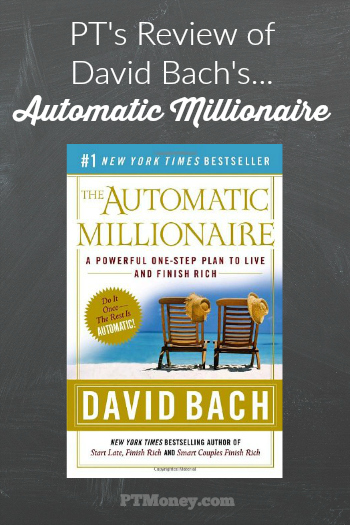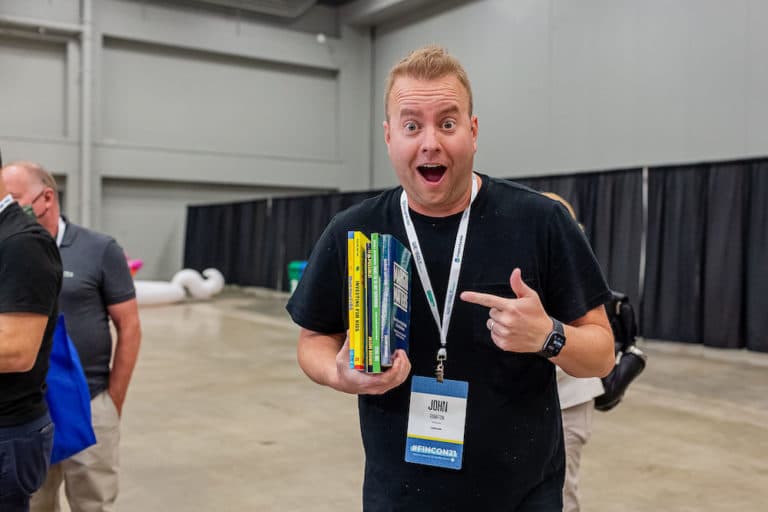Automatic Millionaire Book Review

I recently read David Bach’s Automatic Millionaire: A Powerful One-Step Plan to Live and Finish Rich.
I’d have to say that this book has influenced me the most regarding managing my personal finances.
I picked it up again a week ago and would like to present a quick review here on Part-Time Money. I know the book is a bit old, but most of the material presented is timeless.
Introduction
In the introduction, David gives his motivation for writing the book, as well as some motivation for you to read it. He also spills the beans…he shares that the “one-step” in his one-step plan is to “Make Your Financial Plan Automatic!” That’s it.
He goes on to say that the rest of the book will contain “action steps” to make this happen. So, while there are actually more steps to his plan, his title and approach provide emphasis (and marketing savvy) for getting the main point across, which is really pretty simple.
Be sure and read the philosophy behind The Automatic Millionaire, which is another paragraph in this section. Lastly, David shares a link to a free piece of audio you can access from his website.

Chapter One – Meeting the Automatic Millionaire
In this chapter David shares the story of the first Automatic Millionaires he ever met, the McIntyres. They were able save enough to retire in their early fifties (with $2M in assets) making only around $50K annually. They did this by paying themselves first an average of 10% of their income and prepaying their mortgages by making a half a payment every two weeks.
The McIntyres shared that their most important secret was that they didn’t need will power or discipline because they made it automatic. They setup automatic payments from their paychecks to their retirement accounts and automatic payments on their mortgage.
David does a good job sharing this story of the McIntyres. While I didn’t necessarily identify with their situation, I got the point of the chapter and that is if someone making around 50K a year can do this by their early fifties, I can definitely do it.
Chapter Two – The Latte Factor®: Becoming an Automatic Millionaire on Just a Few Dollars a Day
If you’ve heard anything about from David Bach before, you’ve probably heard of The Latte Factor®. It’s kind of his bread and butter. Basically, he shares that by cutting out one little expense from your day (like your $3.50 latte) and saving that amount instead, you can amass millions for retirement.
The motivation behind this chapter is to eliminate any excuses you might have for not saving for your retirement. Also in this chapter, David shares a few time value of money charts and a one-day assignment to track your spending (worksheet included).
I Don’t Even Like Coffee
I don’t drink lattes. I don’t like coffee at all actually. So, I never took it as an affront that the author David Bach wanted me to give up lattes for the sake of my financial future. In fact, somewhere along the way, I forgot that David actually said to give up your latte.
I thought he just meant that you should save the amount that a latte cost, and you’ll be on your way to millions.
Defending The Latte Factor®
Through the years I’ve heard many people rail against David’s concept: saying that it’s crazy to give up lattes in hopes of retiring early, or with millions (i.e. why give up something that makes you happy).
I cringed reading these comments because as I understood it, David hadn’t said that, and these folks were missing the point. They were certainly missing the higher-level point: that little daily savings can add up to millions over time. Well, it turns out the critics were right, but only partially right.
1. David does tell you to give up lattes (or the equivalent) in his book. But the way I see it, David’s concept relies on the idea that you don’t have room in your budget, that you are barely scraping by. If that’s the case (i.e. you have a fixed income barely covering your basic expenses), then yes, you need to cut the lattes out of your life to be able to save. Check out the ultimate guide to saving money on coffee.
But who the heck is living like that? Not many of us, and I would contend that hardly any of the folks who pick up David’s book live that way. Today’s U.S. consumer (i.e. most of the people reading this blog) have big incomes, often two paychecks per household, a very nice house, two cars, ten pairs of shoes, two flat-screen TVs, and they dine out at least 3 times a week. I’m not saying those are bad things, I’m just saying that it’s ridiculous to pitch the “give up the latte” idea to these consumers. They have it all and can afford it all. They’ll spend it all unless they start automating their savings, which David articulates very well in his book.
2. Most of us don’t have to give up anything. But we do have to start doing something. That’s the real problem that David’s ideas solve, not the Latte Factor® straw man. As a society, we aren’t doing anything proactive to save. Retirement savings statistics are atrocious. It’s not because we have spent our last dollar on a latte. It’s that we haven’t put a single dollar into savings. I’ve said this before: to save money, you need to actually save the money, not just spend less. Saving is the act of physically putting that money into a separate savings account.
Takeaways from The Latte Factor® Chapter
First, in my opinion, it’s short-sighted to dismiss The Latte Factor® because you have something against frugality. It’s only one-part frugality. The other part is about small, automatic savings deposits, which is what people aren’t doing, and which is highly effective towards reaching a solid retirement.
Second, most of us have room in our budgets to save an extra $4 a day towards an emergency fund, house down payment, or retirement fund. Skipping Starbucks tomorrow isn’t the answer to our savings deficiency. We simply need to automate and separate our savings effort.
Chapter Three – Learn to Pay Yourself First
In this chapter, David shares that you can throw away your budget using his method. Then, he delves deeper into the concept of paying yourself first. He explains why it’s better to pay yourself before the government gets their due (taxes) and he gives you the basic concept of how it works.
There’s also an Automatic Millionaire Promise you can sign for extra motivation.
Chapter Four – Now Make it Automatic
If you only had time to read one chapter from David’s book, read this one. This is the real meat of the book. In this 50+ page chapter David gets specific about how you should make your retirement savings automatic.
He starts with people who have access to contribute to a 401K, then moves toward using a IRA where he talks Traditional vs. Roth IRA. Finally, David shares his thoughts on people who are self-employed and how they can make it automatic.
I like this chapter because it gets really specific giving web addresses and phone numbers of investment firms and brokerages. David also endorses balanced funds and asset allocation funds because of how easy they make it for you to invest.
Chapter Five – Automatic for a Rainy Day
In these last four chapters David takes his “pay yourself first” automatic method and applies it to four other areas of your personal finances. The first is emergency savings. His three rules in this area are to: decide how much money you need; don’t touch it; and put it in the right place.
David considers the right place to be money market accounts, or what are actually high-yield online savings accounts. Again, David gets specific at this point by listing out some accounts, along with web addresses, phone numbers, and investment minimums. Capital One 360 (which I thought was just a savings account, not a money market account) is listed first because of their no minimums.
Chapter Six – Automatic Debt-Free Homeownership
David is a strong proponent of owning vs renting and explains why in this chapter. He also suggests that taking out a 100% loan, while risky, is a good option to get out of the rent race too quick. I wonder if he believes that way anymore in light of the current lending situation.
While he does share his thoughts on buying a home, this isn’t a buy a home guide. The real benefit of this chapter comes from his section on making biweekly mortgage payments and how that can help you own your home quicker (22 yrs vs. 30 yrs). If you’re a home owner or considering becoming one soon, this section is worth a look.
Chapter Seven – The Automatic Debt-Free Lifestyle
This chapter is really less about how to make automatic credit card payments, and more about why you should and how to get out of your debt. If you need some extra motivation to get a handle on you out-of-control credit situation, this chapter will be beneficial.
Chapter Eight – Make a Difference with Automatic Tithing
David’s last chapter takes a step back from all this get rich talk and discusses the merits of tithing, how much you should tithe, and how to make it automatic. If you’re unsure of who you should give too, David provides a few examples.
A Final Word: Your Journey Begins Today!
In this final section, David sums up his message nicely and provides a last bit of motivation for getting started on your path to becoming an automatic millionaire.
My Thoughts on the Book
As I already shared above, this book has been very influential on me and my personal finance approach. When I first read it, it either reinforced what I was currently doing or motivated me to begin some of the methods described within.
I really appreciate how specific David gets in the book and how simple he keeps the message. I’d recommend The Automatic Millionaire to anyone looking for some practical application on simplifying their finances and leaving behind, forever, any excuse for not saving.


![Teaching Kids About Money [The Complete Guide]](jpg/teaching-kids-about-money-768x432.jpg)




Halfapayment.com helps you set p the automatic plan… Check it out
This sounds like it is just up my alley. I’ve already got a couple of things on “automatic” such as deposits into savings, IRA, etc., but I have not really gone beyond that. Maybe there is hope for me to get out of debt and make a clean break sometime. Thanks.
Sounds pretty good, I may have a look, though I am always skeptical of tithing….for obvious reasons.